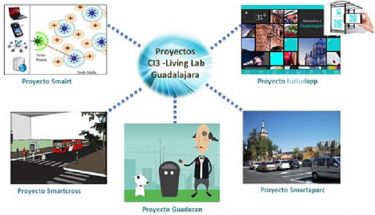
Project Living Lab Guadalajara
One of the most relevant activities of the Innovation Centers, in the environment of Smart Cities, is the promotion of innovation laboratories in urban services, called “Living Lab”.
At the end of 2013 a collaboration agreement was signed between the CI3 and the Guadalajara City Council for the creation and development of the “Living Lab-Guadalajara”, an open innovation space where new technologies are deployed and its operation is tested through its Real interaction with citizens. Its implantation is located in the surroundings of the “Cultural Axis” constituted by Ingeniero Mariño and Ramón y Cajal streets.
The Living Lab of Guadalajara provides new products, services and infrastructures promoting the image of the capital of Alcarria as “Smart City”. In addition, it will allow companies in the area to adopt technologies that can suppose a competitive advantage and to the University of Alcalá a real experimentation environment.
The main projects developed in Living Lab Guadalajara are:
Living Lab Guadacan: Intelligent litter bins for depositing pet waste, which encourages citizen cleanliness and sanitation. The local Citizen Card “XGUADA” allows, through RFID technology, the opening of the bins, the identification of the user and their subsequent access to raffles for discounts in veterinary clinics. The pilot consisted of the installation of 10 paper mills in the Aguas Vivas district.
Living Lab Tuciudapp: It is a new digital channel of communication between the Public Administration, Citizens and Urban Services Companies, which uses QR codes technology attached to urban elements, with the innovative feature of being each of them associated with a content unique and personalized. This channel will benefit tourism, encourage the proximity and contact of the Administration with the concerns of its citizens, contribute to the improvement and knowledge of the various municipal services and promote businesses and businesses in the area. In the first phase of the project, 200 QR codes have been displayed on the streets that make up the Cultural Axis.
Living Lab Smartcross: Monitoring system for pedestrian crossings through artificial vision that detects the presence of pedestrians in the waiting and crossing areas, advising by light signals to vehicles. This system will contribute to citizen security by optimizing transit and waiting times, reducing unnecessary vehicle stops and prolonging crossing times for more vulnerable users. The system has been installed in a pedestrian crossing at the entrance of Ramón y Cajal street.
Living Lab SmartAparc: Detection by artificial vision of the occupancy of parking spaces on the surface, to inform the user without having to enter the car park. The system will be installed in the parking lot near the Concathedral. It will use one or several cameras for image detection for processing them through a series of algorithms and the subsequent publication of free spaces through an information panel and a mobile application.
Living Lab Smairt: Pretends the control of environmental variables for citizen information. For the monitoring of environmental variables such as CO, NO2, O3, SO2 and particles in suspension, it is intended to develop a low-cost sensor system and use the wireless transmission network (also developed by CI3) to send the data to an information panel from which you can view trends or forecasts of evolution of these variables.
In the words of the Hon. Mr. Antonio Román Jasanada, Mayor of Guadalajara:
“The Living Lab provides new services to the city as an Intelligent City, it offers opportunities for companies to adopt new technologies that can suppose a competitive advantage and establishes a real experimentation environment with the University for the fastest implementation of the technology that is there. develop and improve the training offer “
